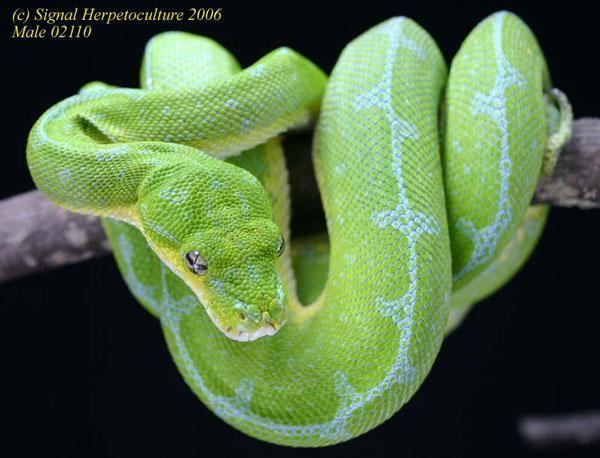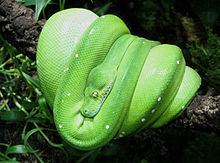Subphylum Vertebrata Suborder Serpentes Rank Species | Phylum Chordata Higher classification Morelia | |
 | ||
Similar Morelia, Snake, Python family, Reptile, Carpet python | ||
Aquaterrarium serpent morelia viridis green tree python
Morelia viridis, commonly known as the green tree python, or as it is known in the herpetoculture hobby, chondro (due to its former classification in the genus Chondropython) is a species of python found in New Guinea, islands in Indonesia, and Cape York Peninsula in Australia.
Contents
- Aquaterrarium serpent morelia viridis green tree python
- Paludarium 1 morelia viridis green tree python
- Description
- Geographic range
- Habitat
- Conservation
- Behaviour
- Diet
- Reproduction
- Captivity
- References

Paludarium 1 morelia viridis green tree python
Description
The green tree python is characterized by a relatively slim body. The relatively long tail accounts for about 14% of the total length. The head is large and clearly defined from the neck. The snout is large and angular. The body is triangular in cross section with a visible spine. The species usually reaches a total length of 150–180 cm (4.9–5.9 ft), but large females may reach 200 cm (6.6 ft). The size also varies depending on the region of origin. The weight is highly dependent upon the nutritional status of the animal. Males can weigh about 1,100–1,400 g (2.4–3.1 lb), females up to 1,600 g (3.5 lb), although wild specimens are typically much lighter than this. Especially large specimens that can weigh up to 2,200 g (4.9 lb) are invariably females, which like most snakes are slightly larger and heavier than males.
Geographic range

They are found in Indonesia (Misool, Salawati, Aru Islands, Schouten Islands, most of Western New Guinea), Papua New Guinea (including nearby islands from sea level to 1,800 m elevation, Normanby Island and the d'Entrecasteaux Islands) and Australia (Queensland along the east coast of the Cape York Peninsula). The type locality given is "Aroe-eilanden" (Aru Islands, Indonesia).
This species is sympatric with M. spilota and the two often compete in the same ecological niche.
Habitat

Its main habitat is typically in or near rainforest, and is primarily arboreal, residing in trees, shrubs and bushes. Occasionally it is seen on the ground.
Conservation
This species is not currently thought to be threatened in its natural habitat, although it remains very popular in the pet trade. Some hunting for food is known to occur in New Guinea.
Behaviour
Primarily arboreal, these snakes have a particular way of resting in the branches of trees; they loop a coil or two over the branches in a saddle position and place their head in the middle. This trait is shared with the emerald tree boa, Corallus caninus, of South America. This habit, along with their appearance, has caused people to confuse the two species when seen outside their natural habitat.
Diet
The diet consists mostly of small mammals, such as rodents, and sometimes reptiles. This snake, like the emerald tree boa, was thought to eat birds; however, Switak conducted field work on this issue. In examining stomach contents of more than 1,000 animals, he did not find any evidence of avian prey. Prey is captured by holding onto a branch using the prehensile tail and striking out from an s-shaped position and constricting the prey. Wild specimens have also been observed and photographed wrapped around the base of small tree trunks, facing down in an ambush position, presumably waiting for ground mammals to prey upon.
Reproduction
Morelia viridis is oviparous, laying 1–25 viable eggs per clutch. Breeding has never been reported from the wild, however in captivity eggs are incubated and protected by the female. Hatchlings are lemon-yellow with broken stripes and spots of purple and brown, or golden or orange-red. For yellow individuals at Iron Range National Park, Australia, the color change occurred over 5–10 days when individuals were 58–60 cm (23–23.5 in) long, which corresponds to about a year old. Colour change for red juveniles has not been observed in the wild.
Captivity
These snakes are often bred and kept in captivity, although they are usually considered an advanced species due to their specific care requirements; once these are met, they usually thrive in captivity.
